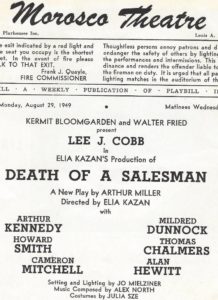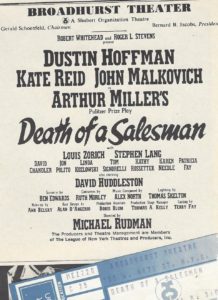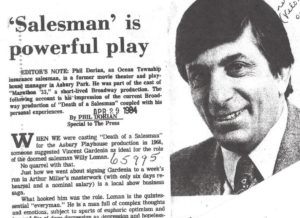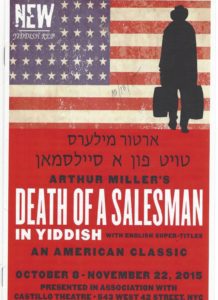Since its premiere in 1949, when it won all six of its Tony Award nominations (and the Pulitzer Prize for Drama), Arthur Miller’s “Death of a Salesman” has had four Broadway revivals, all of which I am fortunate to have seen: in 1975 with George C. Scott as Willy Loman; 1984 with Dustin Hoffman; 1999 with Brian Dennehy; and Philip Seymour Hoffman in 2012.
This piece is prompted by an item in the New York Times about a film of the 1984 revival, which is streaming on several platforms. Not a review or a detailed analysis of the play, this is more a rumination on time spent with it.
In 1984, I was invited by the Asbury Park Press to review the Dustin Hoffman production, based on having played Willy’s son Biff at the Asbury Playhouse years before, with Vincent Gardenia as Willy, Janice Mars as his wife Linda, and Bernie McInerney as other son Happy.
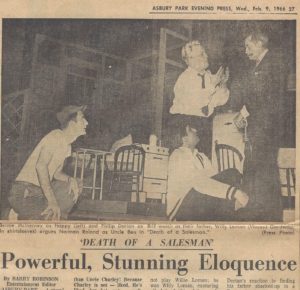
Asbury Park Press review. February 9, 1966. Happy (Bernie McInerney), left, and Biff (me) on the floor as Willy (Vincent Gardenia) confronts his brother Ben (Norman Roland)
I learned recently that the Dustin Hoffman “Salesman” had been resurrected a year after it closed on Broadway (after 91 performances) for the express purpose of filming it. This 1985 film adaptation, which, according to the Times, was “created closely with Miller,” is streaming on several platforms, including for free on Amazon Prime.
My Press article led with comments about how my producing partner Barbara Ley (now Toffler) and I had enticed Vincent Gardenia to accept the role despite a short rehearsal period (six days!) and an Equity-stock salary. His father, who had recently died, had played Willy Loman – in Italian, and Vinnie came to Asbury Park in memory of his father. (Our director Gennaro Montanino’s Italian heritage did not hurt our cause.)
My column went on to discuss the play in general terms. How “everything about ‘Death of a Salesman’ is common…on purpose.” How there is “nothing exciting or dramatic about Willy’s career” and even the selection of Willy’s traveling-sales territory, Rhode Island and other New England states, is part of “the lower-case construction of the play.” “Could anyone imagine,” I wrote, “Willy calling on buyers in Chicago or Dallas?”
About the Broadway revival, I had well-deserved praise for Dustin (although “brilliant performance” might have been a bit over the top) and for the supporting cast. Kate Reid, a “wonderful Linda,” had become tearful at her Brava! curtain call, and John Malkovich’s Biff built from “quiet energy” to “triumphant drama” through the play. Stephen Lang (Happy), Louis Zorich (Willy’s brother Ben), and David Huddleston (neighbor Charley) were singled out, as was director Michael Rudman.
The filmed performance, directed by Volker Schlondorff, retained the stage cast, with the exception of replacing David Huddleston with Charles Durning as Charley. (It is amusing to note that a few years earlier, Charles Durning had proposed marriage to Dustin Hoffman in “Tootsie.”)
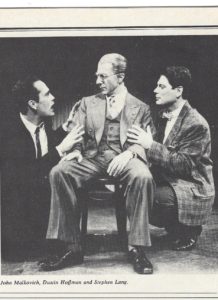
Biff (John Malkovich), left, and Happy (Stephen Lang), flanking Willy (Dustin Hoffman).From the 1984 Playbill
Dustin Hoffman was cast against type. “I’m fat. I’m – very foolish to look at,” Willy tells Linda, bemoaning someone’s “walrus” remark. Curiously though, while Miller specifies that Willy is “past sixty years of age” (Linda pinpoints it at 63), Dustin, at 47, was hardly an anomaly. Vincent Gardenia was 46 in 1966; George C. Scott 48 in 1975; and while Brian Dennehy was 61 in ’99, Philip Seymour Hoffman was 45 in 2012. Lee J. Cobb had originated Willy at just 38. He lost the role in the 1951 commercial movie, however, to Frederic March because of his, Cobb’s, past Communist Party affiliation.
[After being ‘outed’ by Larry Parks in ‘51, Cobb finally capitulated to the House Un-American Activities Committee (HUAC), naming twenty other former Party members. Cleared then to work again, he went on to appear in scads of movies, earning an Oscar nomination as Johnny Friendly in “On the Waterfront.” That film is generally regarded as writer Budd Shulberg and director Elia Kazan’s apologia for their own “friendly” HUAC testimony. Arthur Miller, who defied the Committee, illustrated his more admirable stance a few years later with “The Crucible.”]
Other notable Willy Loman sightings have included my close friend and former producing associate Paul Barry at New Jersey Shakespeare Festival in 1991. In 1998, Ralph Waite, with whom I had appeared in “Marathon ’33” on Broadway, played Willy at Paper Mill Playhouse in New Jersey, and in 2015, Avi Hoffman played Willy off-Broadway…in Yiddish with English super-titles that proved unnecessary.
Last – first, really – there was my introduction to the play in the 1950s: As a freshman at U Penn I was asked by seniors to read from the play’s requiem scene before they cast me as Willy’s neighbor Charley in an off-campus production. Cast members from that decades-ago experience are still among my closest friends.
In his prologue to “Death of a Salesman,” Arthur Miller wrote “I believe that the common man is as apt a subject for tragedy in the highest sense as kings were.” And during the requiem at Willy’s grave, Miller has Charley declare “Willy was a salesman. And for a salesman, there is no rock bottom to the life…A salesman is got to dream, boy. It comes with the territory.” Now to log on to Amazon Prime to spend a couple hours with Dustin Hoffman’s Willy Loman.

